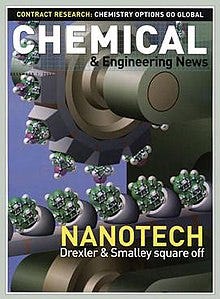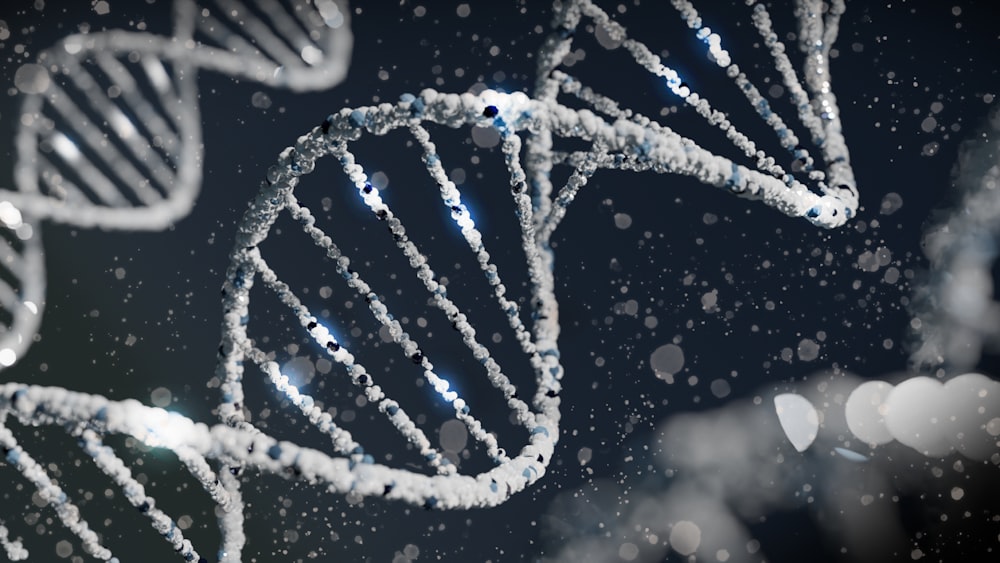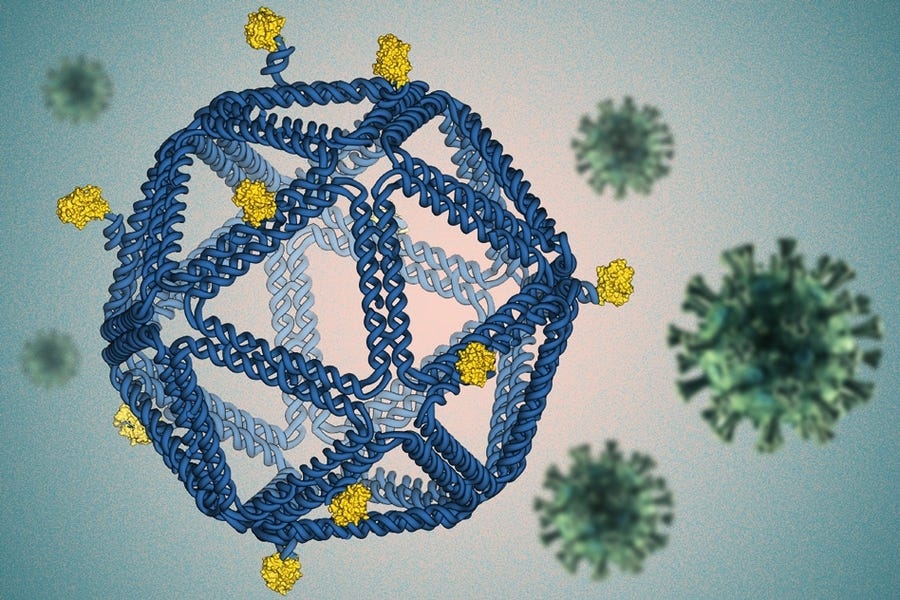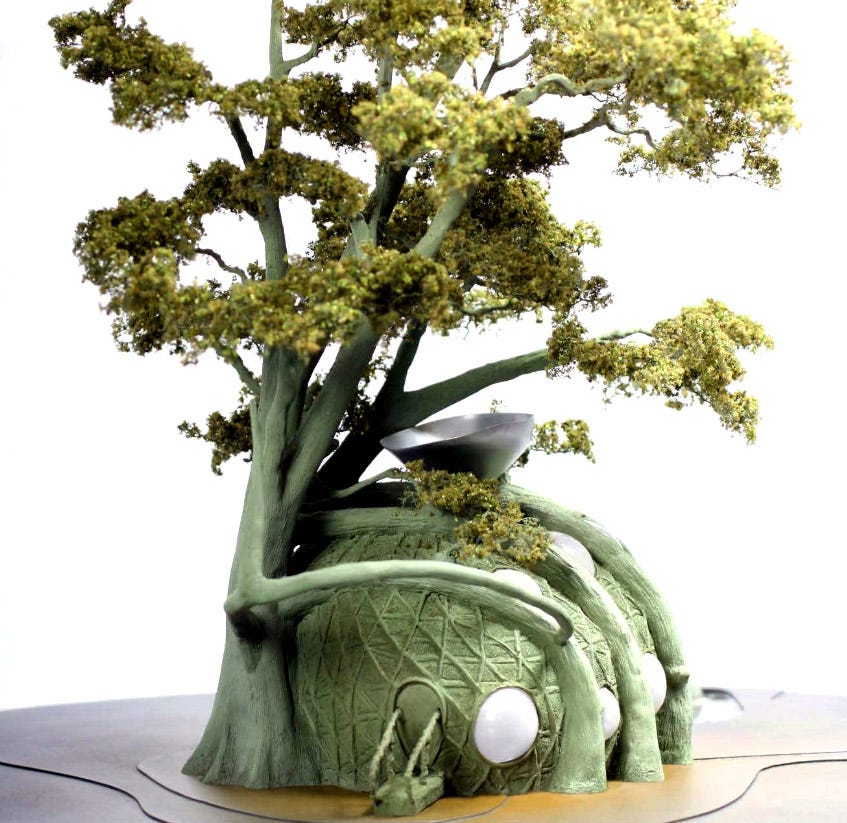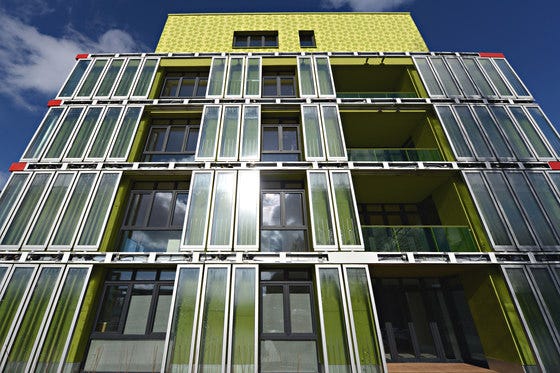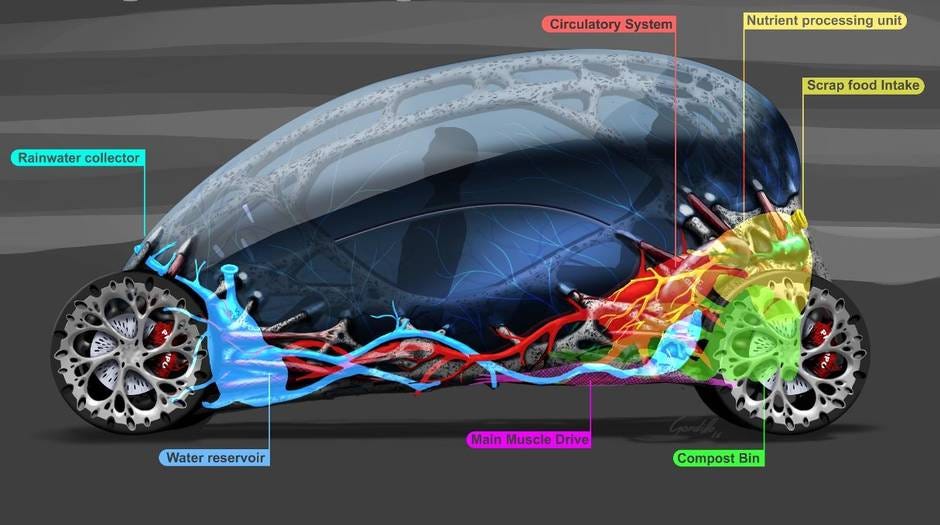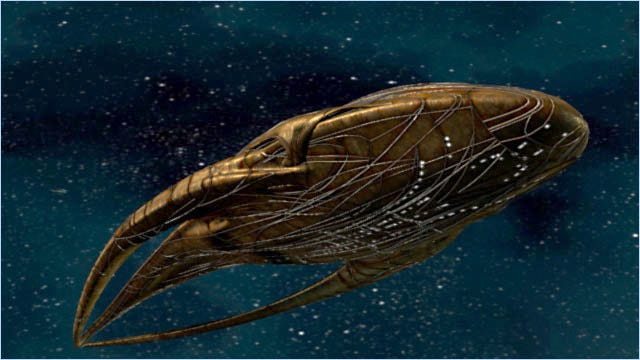Biopunk: Or, what can we reasonably expect out of rock, wood, flesh and bone?
“Biology is wonderous in the vast diversity of what it can build, but it can't make a crystal of silicon, or steel, or copper, or aluminum, or titanium, or virtually any of the key materials on which modern technology is built. Without such materials, how is this self-replicating nanobot ever going to make a radio, or a laser, or an ultrafast memory, or virtually any other key component of modern technological society that isn't made of rock, wood, flesh, and bone?” - Richard Smalley (2003)
The above quotation is passage from the (in)famous Drexler-Smalley debate on molecular nanotechnology. In what has been described as a “pissing match,” of which there are actually many in academia and they are always quite funny, engineer K. Eric Drexler and chemist Richard Smalley fended over the old idea of a “nanobot,” an unfathomably small machine that would be capable of manipulating matter on a molecular scale, assembling complex structures from the tiniest building blocks, as well as possibly making copies of itself.
The debate is well worth reading for anyone who enjoys a good old-fashioned academic banter, but, for the purposes of this post, I will briefly summarize its contents. The exchange started when Smalley, a professor of chemistry who won a Nobel prize for discovering a molecule that kind of looks like a football, wrote an article where he argued that the whole concept of a molecular assembler was impossible, angering Drexler, who had originated the concept some two decades prior. Drexler responded, and eventually pestered Smalley until he agreed to a back-and-forth.
Smalley’s central argument was that nanobots were impossible, or at least that they would be incapable of doing precise chemistry and self-replicate assuming that they could be built, because, (1) they would need a larger number of manipulator arms to control each individual atom than could possibly fit in the nanoscale (Smalley called this the fat fingers problem), and (2) the manipulator arms would adhere to the atoms they were trying to manipulate, making it impossible to release them at the desired position (Smalley called this the sticky fingers problem). Drexler’s response was that his vision for molecular nanotechnology would require no such “Smalley fingers,” as molecules would instead be made to react in the desired ways through positional control, in a manner akin to the workings of enzymes and ribossomes, biological nano-scale structures known to be capable of performing incredible feats of molecular assembly. In essence, instead of individually manipulating every atom of a molecule with a multiplex of tiny arms, the nanobot would bring substrate and reactant together in a specific three-dimensional arrangement and gently guide them towards the desired reaction. In Smalley’s own words:
You need a fairly large group of other atoms arranged in a complex, articulated, three-dimensional way to activate the substrate and bring in the reactant, and massage the two until they react in just the desired way. You need something very much like an enzyme.
Smalley, however, while gladly acknowledging that such a lifelike structure would be capable of complex chemistry, was quick to point out that enzymes and ribossomes can only do what they can in an aqueous medium, since the precise motions of their molecular moving parts are driven by interactions with the surrounding water molecules.
How are you going to replace the loss of the hydrophobic/hydrophilic, ion-solvating, hydrogen-bonding genius of water in orchestrating precise three-dimensional structures and membranes? Or do you really think it is possible to do enzymelike chemistry of arbitrary complexity with only dry surfaces and a vacuum?
Drexler had no satisfactory answer to this question, and this was what made him lose the debate in my eyes. Instead of owning the analogy, and detailing how he thought an enzyme-like structure could operate outside water, he retreated into a more mechanical paradigm, one that makes it appear he actually believes in “Smalley fingers” after all.
These nanofactories contain no enzymes, no living cells, no swarms of roaming, replicating nanobots. Instead, they use computers for digitally precise control, conveyors for parts transport, and positioning devices of assorted sizes to assemble small parts into larger parts, building macroscopic products.
This allows Smalley to emerge as the victor of the debate, in my opinion, though doubtless many would disagree. Drexler seems confused, and at times contradictory. He either fails to understand the type of chemistry that his ideas would require, or has no idea of where such a chemistry could actually be found. As Smalley concludes:
Any such system will need a liquid medium. For the enzymes we know about, that liquid will have to be water, and the types of things that can be synthesized with water around cannot be much broader than the meat and bone of biology
However, while I have no choice but to be on Smalley’s side here, I think that he, like Drexler, underestimates biology. There is a lot more that meat and bone can do than what at first meets the eye.
Allow, then, this scientific “pissing match” between a chemist and an engineer to serve as an overly elaborate framing device for an exploration of the limits and potentials of biotechnology. What can we realistically expect out of rock, wood, flesh and bone? Are they as limited as Drexler and Smalley believe them to be, or can they uplift civilization as much or even more than the mechanical dreams of the past century’s futurists?
What will follow for the rest of this post is a short, conceptual worldbuilding exercise in the under-utilized science-fiction genre of “biopunk,” with more emphasis on the bio and less emphasis on the punk, seeing as I am generally an optimist(-ish) and I have more interest in the science and technology part than in imagining a dystopian society.
1: Assumptions of a “biopunk” setting
Science fiction and futurism do not usually pay much attention to the biological sciences, preferring to focus on other things such as space exploration/colonization and Artificial Intelligence. This is partly a reflection of the most usual backgrounds of people creating this type of content, but the obvious consequence is that the average person does not envision biology playing a very large role in the most transformative developments of the 21st century.
My goal here is not necessarily to challenge that assumption. I personally find it quite tiresome to try to talk about the future as if we could actually predict it. Far for more interesting, in my opinion, is to explore possibilities.
So here’s a possibility: for the near to medium term future (let’s say, what’s left of the 21st century), non-biological fields of research progress only modestly, while the biological sciences and biotechnology see massive sustained improvements over the decades.
To break this down in more specific terms:
Artificial General Intelligence does not become a reality within the course of this century. AI continues to evolve, as is inevitable, but remains largely confined to “narrow” models capable of performing specific tasks better than any human could, but never fully replacing humans. Eventually, with the end of Moore’s law and the failure of all attempts to restart it, the entire field plateaus somewhat and all that happens is relatively small incremental improvements on existing AI.
“Dry” Molecular Nanotechnology never becomes a reality due to the “fat fingers” and “sticky fingers” problems identified by Richard Smalley and the failure of drynano proponents at demonstrating the possibility of non-aqueous enzyme and ribossome-like chemistry.
Space development continues at more or less the same sluggish pace of the last few decades. Launch costs continue to go down, and by the end of the century we have more active and impressive space programs, but no massive human presence outside Earth. Just more and larger space stations, and maybe some light presence on the moon. Also, robotic probes have been sent everywhere in the Solar System and beyond, broadcasting back valuable scientific data, but people themselves don’t usually go very far.
Also, to fend off the no-fun hyper-doomerist predictions of people who say our future will inevitably involve some sort of civilizational collapse or even human extinction, we will posit a difficult and painful but ultimately successful transition to 100% renewable energy production within the next few decades. This turns out not to be enough to avoid some really nasty consequences of global warming, leading to millions of displaced people in developing countries and widespread social turmoil, but no human extinction or civilization collapse. Humanity comes out of it bruised and battered, but definitely still standing, and in the meanwhile, it has had time to greatly improve its biotechnological capacities.
The central question of this scenario thus becomes: how far can humanity go with only the tools of biology at our disposal?
2: Bionanotechnology
“So my position is that there will be a radical nanotechnology that will be powerful and different from what’s gone before, but it will need to learn nature’s lessons. There are two ways of doing this: either steal bits of nature, biological nanocomponents, and incorporate them into synthetic structures—I call that biokleptic nanotechnology, or you can try using nature’s design principles but with synthetic materials—I call that biomimetic nanotechnology.” - Richard A.L. Jones
Firstly, to engage directly with the Drexler-Smalley debate that I used to set this up, I will address the potential of biological molecular nanotechnology. Is it actually more plausible than “dry nano”? What are its actual limitations?
In a 2005 essay entitled “What biology does and doesn’t prove about nanotechnology” (quoted above), Materials Physicist Richard A.L Jones criticized the Drexlerian vision of nanotechnology and proposed a different philosophy that embraced the “floppiness” and randomness of biology.
How does muscle work? It’s Brownian motion plus lack of stiffness. That gives you the idea of conformational transitions. Astonishingly, if you ask the mechanistic question, how does your muscle work? i.e. what actually makes the molecule change shape, the answer is its collisions with the water surrounding it (…)
Jones then goes on to distinguish between “biokpletic” and “biomimetic” approaches to biotechnology. The first seems to have a large overlap with the emerging field of Synthetic Biology, as it aims to either create new biological systems or to tamper with existing ones to fit human ends. The second would use synthetic materials but not living ones, making it “life-like” and almost certainly still “wet” nanotechnology, but not exactly biological. How far have we come with either of these approaches in the years since Jones’ essay?
Starting with the biokleptic side of things, two main areas of research seem to have emerged: that of DNA-based nanotechnology and that of protein-based nanotechnology. DNA and proteins are both versatile biomolecules capable of taking on complex three-dimensional structures, so it’s certainly not hard to imagine how they could both form the building blocks for the mythical nanobot.
DNA holds the advantage of being highly programmable and inherently information dense. Its double helix secondary structures can fold in numerous ways, generating nanoscale structures of many different shapes. A technique called DNA Origami uses small fragments of single-stranded DNA (ssDNA) to guide the folding of a much longer strand into any desired three-dimensional conformation.
Properly folded DNA structures can then serve as scaffolds, immobile structures guiding the positioning of other molecules in space, walkers, mobile structures capable of transporting molecules from one place to the other (probably what we would associate the most with the word “nanobot”), and many other potential modalities of dynamic and programmable devices that could form part of a nanotechnological assembly line. In fact, over ten years ago, scientists had already constructed such an assembly line:
Here, we demonstrate that a nanoscale assembly line can indeed be realized by the judicious combination of three known DNA-based modules: a DNA origami tile that provides a framework and track for the assembly process, cassettes containing three distinct two-state DNA machines that serve as programmable cargo-donating devices and are attached in series to the tile, and a DNA walker that can move on the track from device to device and collect cargo. As the walker traverses the pathway prescribed by the origami tile track, it encounters sequentially the three DNA devices that can be independently switched between an ‘ON’ state allowing its cargo to be transferred to the walker, and an ‘OFF’ state where no transfer occurs. We use three different types of gold nanoparticles as cargo and show that the experimental system does indeed allow the controlled fabrication of the eight different products that can be obtained with three two-state devices.
This offers a glimpse of what the future might hold. As DNA-based nanoscale assembly line becomes more complex, the diversity of what they can produce will only increase, leading to powerful and versatile nanofactories.
There is also reason for optimism in the self-replication department, with strategies including propagating tile motifs and auto-catalytic complexes, and interactions with DNA computing can greatly increase the scope of programmability.
The field of protein-based nanotechnology is comparably more recent. In natural life, proteins perform a much wider variety of functions than nucleic acids, helped by a much more diverse composition that allows different chemical properties to be achieved more easily. They are, however, less programmable than DNA, especially owing to their less predictable folding behavior, molecular interactions and chemical activity. Recent breakthroughs in artificial intelligence now allow us to accurately predict a protein’s structure just from its amino acid sequence, which certainly makes it easier to design new ones and modify those that already exist. In fact, while the breakthrough is very recent, efforts to apply to protein design efforts are already on their way. But the problem is that it’s not always easy to connect structure to a specific function. In many ways, however, proteins are already the perfect nanobots as they are. They can guide chemical reactions, serve as structural building blocs and even molecular motors, so if we can find ways to predictably design and program them, they may hold even more potential for nanotechnology than DNA.
To finally address the field of biomimetic nanotechnology, nanozymes have recently been gaining traction as non-biological molecules exhibiting enzyme-like behavior. The advantage of using something like them as the building blocks of our nanomachines, is that they are less sensitive to their environment than proteins and DNA, being less likely to lose their structure as a result of pH and temperature fluctuations, or interactions with other proteins and biomolecules.
3: Unexpected Biotech
OK, so, we have now established that we can create nanomachines out of biomolecules or their synthetic equivalents, but they still only work on water, right? So what can they do? We still haven’t answered Smalley’s question.
The potential applications of bionanotechnology and synthetic biology to medicine, food production, bioremediation and other areas thought of as inherently biological are of course extremely vast, but they are mostly topics for future blogposts. Here, I want to explore less conventional avenues for biotechnology. How could life be engineered to fulfill roles that we typically envision as being filled by completely different types of technology?
Indeed, life cannot make “a crystal of silicon, or steel, or copper, or aluminum, or titanium,” but that does not necessarily mean it cannot build “a radio, or a laser, or an ultrafast memory.” All it takes is a little bit of imagination to envision technology that does the same things while being built of different materials.
For starters, there is an entire field of organic electronics, where organic polymers like Polyaniline and Polythiophene are used as conductors as semi-conductors instead of silicon, copper and aluminum.
Organic Field Effect Transistors (OFETs) have existed since the 1980s, and there are also Organic Light Emitting Diodes, Organic Solar Cells, and more. These are usually produced using conventional industrial methods, but, considering they’re made of exactly the same elements that make up “meat and bone,” there is no reason why they could not be assembled using DNA or protein-based nanotechnology. After all, if there is something that life most certainly excels at, it is bringing together repeating units to create polymers. That is essentially the way in which every large biomolecule comes to be.
In 2018, the Semiconductor Research Corporation (SRC) released a roadmap for “semiconductor synthetic biology” research, which dedicates a chapter precisely to the use of synthetic biological systems for semi-conductor fabrication and integration. The authors offer a strong defense of the concept:
Semiconductor chip fabrication is very energy and resource intensive. Thus, the discovery of new manufacturing approaches that reduce these expenditures would be highly beneficial to the industry. In comparison, living systems fabricate complex nanometer-scale structures with high yield and low-energy utilization. For example, biological self-assembly occurs at a rate of ~1018 molecules per second (at biological growth rates a 1 Gb chip could be built in about 5 seconds), and energy utilization of ~10-17 J/molecule, which is 100x less than that of conventional subtractive manufacturing. Combining these capabilities of living systems with synthetic DNA- or protein-based self-assembly offers transformative potential for revolutionizing the synthesis of complex, sub-10 nm information processing architectures.
Interestingly, they start the chapter not by focusing organic electronics or other alternatives, but by highlighting the potential of biology to produce components of conventional electronic devices, including discussions on DNA-based lithography and DNA-based assembly of metallic nanowires. So perhaps we should challenge Smalley even more strongly. Even if life cannot produce a crystal of silicon, it can at least shape silicon to a very significant extent, and the same ought to be true for many of the other materials that form the backbone of conventional technologies.
Nevertheless, the authors of the roadmap call for a new material base for electronics, citing sustainability concerns and the desire for bio-compatibility and bio-degradability in future electronics, regardless of how they are produced.
The chapter mentions several interesting areas of research. One of them focuses on the Geobacter sulfurreducens species of bacteria, known to naturally possess an electrically conductive pili, which can be improved through genetic engineering and potentially form the backbone of entire networks of nanowire. Another one envisions fibroin, a protein present in silk, as a material to build transient (biodegradable) electronic devices.
It seems clear that biology is perfectly capable of producing electronics. However, it may be a telling that the bulk of the SRC’s 2018 roadmap to semiconductor synthetic biology is actually not spent discussing that possibility, but different types of information processing structures that may complement or replace electronics in the future.
Discussed topics include using DNA for data storage and cell-cultures as computers.
In fact, the idea of using biochemical information processing systems to perform computations is far from new! It goes back to the 1980s, and proof-of-concept exists at least since 1994, when computer scientist Leonard Adleman solved an instance of the Hamiltonian path problem using an entirely biological computer.
The field has seen some progress over the decades. Once again, as in nanotechnology, DNA-based systems receive most of the attention, but there are also approaches that use enzymes, motor protein filaments, bacterial cell cultures, and even human neurons in a petri dish.
While biological computers may find it difficult to surpass their electronic counterparts in some ways, many experts believe they may hold a significant edge where it comes to certain particular tasks, especially those that require a large amount of parallelization and stochasticity.
But enough about electronics and computing! What other fields can biology take over?
It could easily provide a replacement for plastics, and that alone means it could produce a large portion of our everyday utensils. Things made of metal might be slightly more challenging, but sufficiently resistant organic polymers could prove a suitable replacement.
A more fanciful and exotic possibility might be biological buildings. These are also not as far-flung as they may seem.
Mycelium fribrous fungal colonies are pound-by-pound stronger than concrete, and can grow to a massive size, making them attractive as an architectural building material. In 2014, New York architect David Benjamin inaugurated the Hy-fi tower outside Long Island’s museum of modern art. Somewhat inaccurately dubbed a “Murshroom Brick Tower,” it is actually composed of bricks made of mycelia bound to agricultural waste.
The bricks were then piled up in the traditional way, but one can easily imagine a future where we’ve genetically engineered mycelia to sprout these structures on their own. Or perhaps biological nanobots can step in to build them instead.
Regardless, Mycelium is by no means the only candidate to the title of premier biological building material. Another, potentially far more obvious option, is trees. MIT architect Mitchell Joachim and his Terraform ONE think- tank have proposed the Fab Tree Hab project, consisting of allowing trees to grow over a pre-fabricated scaffold.
It’s a rather old project, from which there sadly appear to have been no news in over a decade, but as a concept it’s still rather intriguing. In the future we may not even require prefebricated scaffolds, the trees themselves could be programmed to take the shape we want them to, and once again there’s biological nanobots…
While a potential downside may be that trees usually take a long time to grow, there are some very fast growing trees, and that’s only in nature. Through genetic engineering, it is likely possible to greatly increase their growth rate.
Algae also offer interesting possibilities, especially for heating and power-generation. The BIQ House in Hamburg Germany prides itself of being “The first algae-powered building in the world.” Its facade is covered with flat panel-shaped bioreactors filled photosynthetic micro-algae, which function as solar panels to keep the house in the winter.
Branching out of architecture, using bioluminescence for street-lighting is a possibility. The easiest way to accomplish this would be simply to gow bioluminescent bacteria inside glass containers and use the containers as lamps, as already happens in the French town of Rambouillet. But a more aesthetically inspiring endeavor might be to genetically modify trees to be bioluminescent, like the famous fictional ones in the movie Avatar.
Sadly, people have been trying to do this for quite some time and without much success. Still, while it appears to be more difficult than one would think, there is no reason why it should be impossible, and the end result would just be too pretty for it not to be done. Someone should be able to figure it out eventually.
Anyway, to push the boundary even further, let us discuss biological vehicles as well. These seem to be comparatively under-investigated, even at a purely conceptual level. It’s a different story if we talk about bio-inspired vehicles or vehicles powered by biomass, but seldom is there any talk of actual living vehicles made of flesh and bone. If we just wanted to meet Smalley’s challenge, we could simply envision a car, a train or a boat assembled by biological nanomachines, made out of organic polymers and incorporating organic electronics or biological circuitry. Power could be generated from organic photovoltaics, or other renewable option.
This would be very interesting just on it’s own, but we all know we want flesh cars! The only real world project I managed to find was the Bionika car, seemingly reported only in a single obscure newspaper article from 2016.
It is, nevertheless, an intriguing concept. It will surely go nowhere, but it can provide us with an idea of what might be in the future. Canadian engineering Charles Bombardier writes:
The Bionika’s frame is made of a conductive graphene composite and rigid organic material. The living tissues are grown in a biotech lab and are assembled on a factory line. Basically it has a stomach that digests processed food scraps and feeds the energy to a powerful muscle designed to propel a crankshaft. The back-and-forth movement of the muscle would be converted into a circular movement and the excess energy could be store inside an organic battery (ORB). The crank would be connected to a mechanical transmission.
He then goes on to explain how the car is effectively a biological organism with its own circulatory system and which would breath and eat just like an animal. He nevertheless points out that it would not have a nervous system, avoiding any complications of potentially creating a sentient being.
It’s a set up that could easily be envisioned for other types of transportation like trains and boats as well. For things like submarines, airplanes and even spaceships (of course, living spaceships have been a staple of science fiction since forever!), I personally have always imagined biological versions of these vehicles looking something like squids, which as we all know are capable of jet propulsion.
But regarding biological spaceships, a lot more has been written on them than other means of transportation. In fact, there is a whole field called space synthetic biology, and NASA has conducted research on it. Naturally, the focus is less on wholly biological spaceships and more on more tenable ways of integrating biology into space technology, especially in life support, waste disposal and in situ production of things that astronauts may need. So it’s more about biological spaceship parts than biological spaceships as of now, but it’s certainly a start. And indeed, some engineers have already gone as far as to propose growing trees inside an aerogel layer and using them as spaceships.
While to some the idea of a fully biological space vehicle may seem like ridiculous schizotech, there are actually obvious advantages, as bioships would most likely be cheaper than conventional spaceships and also have a greater capacity for self-repair., so I would not count them out for sure.
4: Expected Biotech
The more obvious possible avenues for biotech, for the most part, need no introduction, and I could - and probably will - write truly gargantuan blogsposts about every single one of them. However, that is not our purpose here, so I will simply skim over them for the sake of filling in the gaps of our biopunk world.
Biotechnology can feed the planet: The human population has just hit 8 billion and will continue to increase in the near future, although mostly in the developing world. Decades ago, pessimists predicted we could not even feed this many. They were proven wrong by the Green Revolution, a wave of agricultural technological innovation that massively increased our food production capacity. Now, modern has the potential to once again transform food production. Plants can be genetically engineered to grow faster, bigger and more nutritious, or to become pesticide resistant and grow on less fertile soils and more adverse climates. Lab-grown meat from animal stem cell cultures can eliminate animal husbandry, replacing it with a more environmentally solution and ending the slaughter of sentient beings for food.
Biotechnology can heal the environment: Bioremediation is a vast field of studies that seeks to use living beings, especially genetically engineering bacteria, to safe eliminate pollutants such as plastics and metals from the environment. Besides that, there are the already mentioned fast-growing trees, which could repopulate our forests and regenerate their carbon capture and oxygen generation capacity. Finally, genetic science also offers us the chance to protect endangered species by sequencing their genomes and artificially creating new individuals by modifying a similar species’ gametes, or even to bring back extinct ones the same way.
Biotechnology can treat diseases: This one requires no explanation. New therapies for cancer and neurodegenerative diseases, personalized therapies through bionanotechnology and stem cell transplants, regeneration of entire body parts, etc.
Biotechnology can conquer aging: Only different from the previous one if you do not consider aging to be a disease. There are several ways in which this could be done (depending on a lot of things that we really don’t know about aging), but my current thinking is that it would be most likely to be achieved through a damage-like approach as advocated by the SENS Research Foundation, although not necessarily through SENS’ specific research plan.
Biotechnology can expand human abilities: Transhumanists have long dreamed of an improved humanity, either through merging with machines or through biological modifications. In our biopunk, this will naturally occur primarily through biology. Genetic engineering of humans will most likely be very slow to take off due to ethical and legal obstacles, we are likely to already have transformed non-human life to an immense degree by the time we start tinkering with our own genome. Interventions to treat or prevent diseases will be green-lit before augmentation, and gene therapies that can be applied on adults will also become available faster than anything done on the germline level. Ironically, the most common types of biological augmentation of humans will probably be more similar to what people envision “cybernetic” augmentation to be. Imagine one of those organic or biological computers we’ve discussed earlier implanted in your brain, interfacing with your nervous. It was probably assembled there by a swarm of biological nanabots. You have millions of those in your body, flowing through your veins, keeping your tissues and cells healthy, monitoring your health and maybe even improving your performance, reinforcing your muscles with ultra-strong organic materials, promoting the growth of new synapses in your brain, etc. Imagine replacing a limb, as in a cyberpunk story, but instead of a robot arm, you get an improved biological arm, grown for you in a vat and much stronger than a normal human arm.
5: Our Biopunk World
So, with all the conceptual work done, let us try to sketch a picture of what our optimistic biopunk world might look like by the turn of the century. Once again, I chose the word “biopunk” solely because my interest was to explore the limits of what can be achieved with biological technology alone. Maybe one day I will do justice to the “punk” part of the word and imagine how these technologies may be used in a hellish dystopia, but this post is primarily focused on examples of things going right. Aesthetically, what I have in mind has some things in common with “solarpunk,” the only one of the “punk” sub-genres of science fiction to be invariably optimistic.
Imagine cities filled luscious green, civilization and the biosphere merged in a number of intricate ways…
In this world, most buildings from our time are still standing, and many new ones were built in the conventional way, but in cities all around the world one can now see marvels of biological engineering sprouting through our landscape of metal and concrete. Beige towers of mycelia, trees bent and warped to form houses from which luscious green leaves sprout, tiles filled with algae adorning the facade of buildings. Wheeled vehicles made of flesh roam the streets, glowing trees illuminate the night. And up above in the sky, living spaceships depart to colonize the solar system.
Everyone has in their house a biofabricator, an oven or maybe fridge-sized device filled with an aqueous medium where swarms of biological nanobots swim freely and purposefully, forming sophisticated assembly lines that produce a variety of items for the entire family. Clothing of all shapes colors and sizes, bioplastic utensils for daily use, toys, paper and all manner organic electronic devices or their equivalents that make use of biological information processing systems instead. If necessary, the biofabricators can also produce food, but most people prefer to buy actual (genetically-engineered) vegetables grown at the world's great farms which can now feed countless billions for cheap.
Each city has its own biomass distribution system, a network of pipes and valves through each recycled organic matter flows and feeds biofabricators with the raw materials necessary for their creations. For those who cannot afford to have their own biofabricator at homes, local authorities provide public ones to freely meet the needs of the downtrodden. In almost all expect, think of a set up very similar to that of matter compilers in the Diamond Age, but with biological rather than Drexlerian nanotechnology and hopefully with no Victorian era social stratification.
Humans are effectively immortal, but overpopulation is of no concern thanks to the improvements in food production and recycling, and the bioships are making sure we do not stay confined to only one planet anyway.
Most people sport some form of biomodification, but the most common ones are not genetic or at least not hereditary. Medical upkeep biological nanobots are ubiquitous, and many have elected to have their nanobots build something new inside their bodies. The most common option is by far organic or biological computers embedded in people’s brains, interfacing with their nervous systems and providing cognitive and memory enhancements as well as the possibilities of brain-to-brain communication (think Night’s Dawn Trilogy-styled empathy) and interactions with virtual reality. Also common are enhanced muscular and skeletal structures, reinforced with ultra-strong biomaterials, making people both more physically capable and more resistant to accidents.
Such a society would most likely be on the brink of post-scarcity, if such a thing is even possible, or at the very least be highly affluent and advanced. Almost all the dreams of several generations of science-fiction readers and writers would have been realized through biology alone.
It is possibility that, rather than being a consolation price for the disgruntled nanotechnologist, the wondrous world of biology, the world of rock, wood, flesh and bone, may actually contain all that we need to move towards a brighter future.






